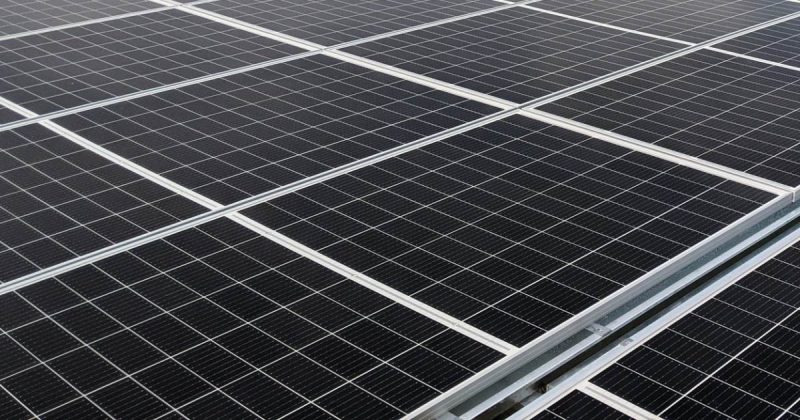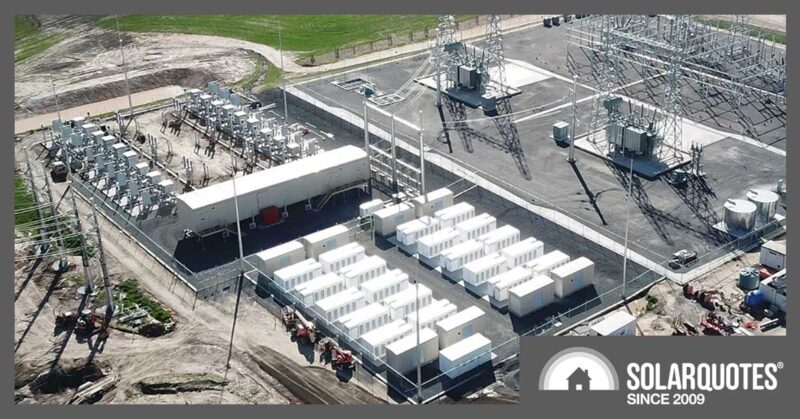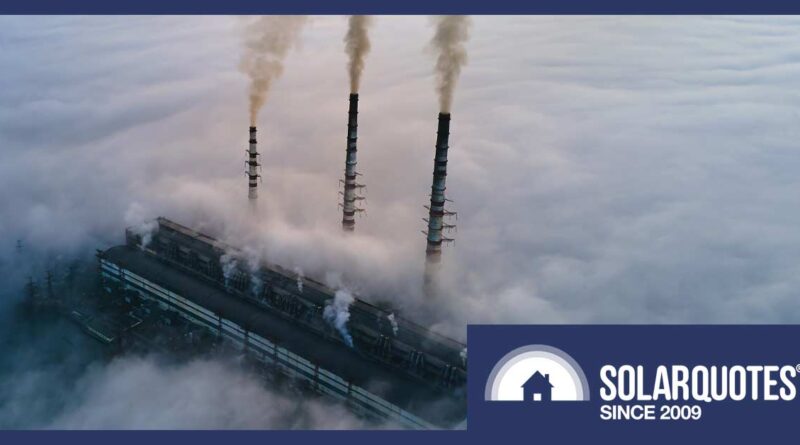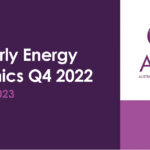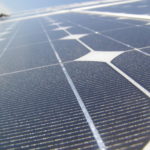Good News! 2022 Was The Worst Year Ever For Greenhouse Gas Emissions
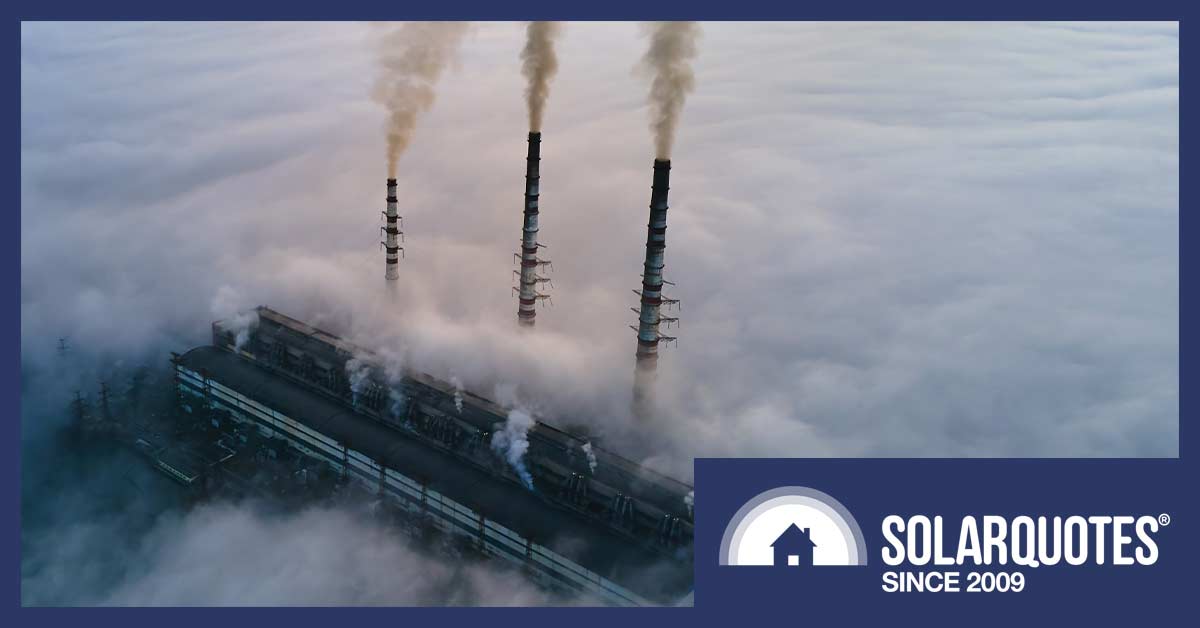
2022 is on its final legs and soon to expire. Even though it’s disrespectful to speak ill of the soon-to-be departed, I’m going to come straight out and say — when it came to greenhouse gas emissions — 2022 was the absolute worst.
Human activity caused more emissions this year than any other. The final figures aren’t in, but they’re expected to be 0.8% higher than 2021 — the previous record holder.
That’s an extra 300 million tonnes: the weight of half the water in Sydney Harbour and even heavier than that fridge your mate swore would easily move between the two of you.
Good News?
Thanks to superhuman levels of optimism, I’ve found a silver lining on this massive cloud of heat-trapping gas. From 2023 onwards, emissions should be heading down. I can’t guarantee 2022 will be the peak, but I’m willing to bet on it. However, not everyone is as optimistic. For example, the United Nations isn’t expecting a decline until around 2030.
The reason I’m optimistic is that — after a lot of foot-dragging — we’re now getting many things right.
Four areas where we’re improving rapidly are…
- Wind and solar power generation
- Electric vehicles
- Energy storage
- Energy efficiency
To understand my reasoning, read on. If you just want to place a bet, please send your stake to my mother to hold. I’m very optimistic that she can be trusted.
Record Breaking Emissions
Greenhouse gas emissions from human activity have three main sources:
- Burning fossil fuels
- Land clearing
- Agriculture
Note for angry old men before they comment: Carbon dioxide from human breathing is not included. The carbon that comes out of your mouth comes from plants that recently absorbed it from the atmosphere. What we breathe out is in balance with what plants take in. Greenhouse gas emissions from human digestion aren’t counted, as they’re supposedly trivial — although I have met people who have made me wonder if that’s actually true.
The emissions we’re worried about are not in balance and, for the most part, build up in the atmosphere and trap heat and contribute to global roasting. The Word Emissions Clock says these will be 57.8 billion tonnes in 2022. The International Energy Agency (IEA) looks at carbon emissions from fossil fuel use and estimates they’ll come to 33.8 billion tonnes.
Carbon dioxide is the largest component of our emissions and has the largest overall warming effect. Next is methane and then nitrous oxide. This makes laughing gas our third largest contributor to climate change. This is no laughing matter, despite being kind of funny.
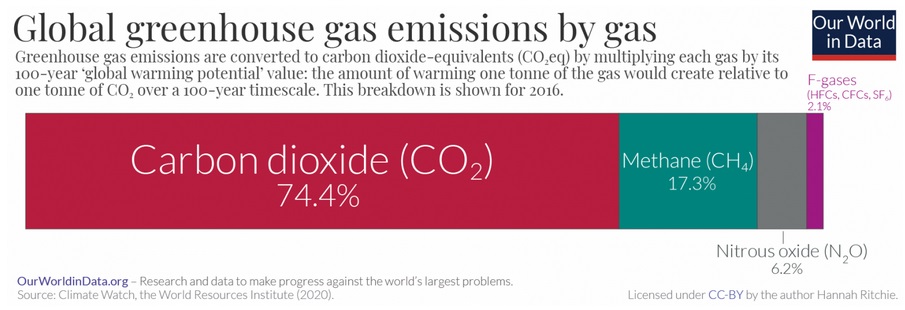
Our emission totals are given as CO2 equivalents where the warming effect of methane and other greenhouse gases are converted into the equivalent amount of CO2 for convenience.
The 2022 CO2 equivalent figure of 57.8 billion tonnes of emissions is enough to cover Australia with a 4.3 m thick layer of carbon dioxide. This is deep enough to asphyxiate anything shorter than an adult giraffe.
The Rise & Coming Fall Of Emissions
The graph below shows the rise in annual global emissions from burning fossil fuels going from next to nothing 170 years ago to just under 38 billion tonnes in 2021. I added a black dot to the graph to show the estimate for 2022:
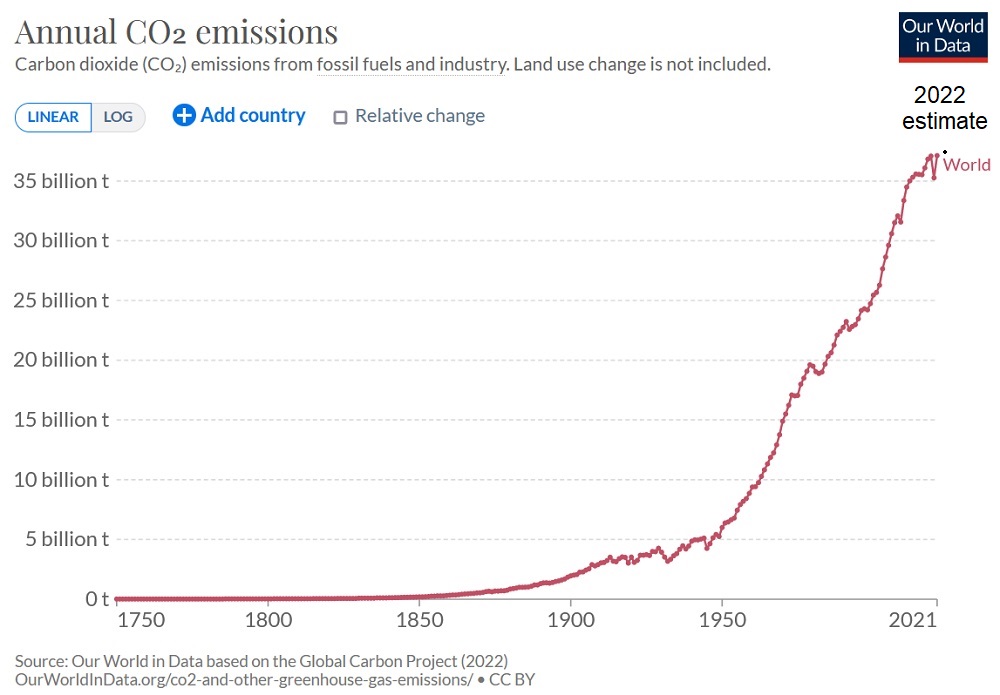
This graph is from Our World in Data, but I personally defaced it by adding the estimate for 2022.
As you can see, for three of the past four years, emission levels have been very close. The exception was 2020 which saw the largest fall in history thanks to the pandemic. If we ignore that year, then it looks as though carbon dioxide emissions have almost levelled off. I’m expecting them to be below the peak in 2023 and every year after.
The decline may be gradual at first, but as fossil fuel replacement switches into high gear and improvements are made to land care and agriculture, I’m hoping the fall will become faster than its rapid rise in the second half of the 20th century.
Fast Emission Cuts Required
In 1882 the concentration of CO2 in the atmosphere was 284 parts per million. It’s now 419 parts per million. We’ve raised a vital component of the biological and temperature balance of the Earth 48% over the past 140 years.
We’ve fiddled more than is generally considered wise.
With help from methane and other greenhouse gases, this has raised global temperatures by around 1 degree. This may not sound like much, but it’s already causing plenty of problems. In the last ice age glacial period 20,000 years ago, sea levels were 120 m lower and our ancestors were hunted by giant cats. I don’t want our descendants to experience whatever may happen if we go too far in the other direction.

Tragically, our ancestors only ever rode sabretooth cats in the sense that I give my lunch a ride after eating it.
If we want to keep the world’s climate, ecosystems, and agricultural zones in a state vaguely similar to how Grandma and Grandpa found them, rapid emission cuts are vital. Unfortunately, modest emission reductions won’t stop greenhouse gases building up in the atmosphere. Without major cuts, concentrations will keep rising and the Earth will keep roasting.
The 80% Solution
If global greenhouse gas emissions are cut 80% it will cause their levels in the atmosphere to roughly stabilize. This is because they will more or less be in balance with natural processes removing them from the atmosphere — with the main one being absorption by the ocean. This would be a massive improvement over what’s occurring today but, while it would slow global warming, it wouldn’t stop it.
Temperatures would slowly rise for centuries because it takes time for the ground and oceans to warm up and for ice to melt. It’s like when you take a chop out of the freezer. It takes time for it to match the temperature of the atmosphere and the earth is a bloody big chop.
Because an 80% cut should stabilize greenhouse gas concentrations, it may seem like a 90% cut would allow natural processes to gradually remove the excess we’ve added to the atmosphere. Unfortunately, there would only be a modest reduction in their concentration before they mostly stabilize again. What we should do is reduce global emissions down to net zero as rapidly as we reasonably can to maximize the amount of CO2 that gets drawn down by natural processes before a new equilibrium is established.
In the future, I think it would be a good idea to actively remove CO2 and potentially other greenhouse gases from the atmosphere to further slow or completely stop global warming. But we can work out the details in the future. As my mother used to say, “If you find yourself in a hole, the first thing to do is stop digging.”
And my father used to say, “If you’re on fire, you should try to quit smoking.”
This always made me think my father was a lot crazier than my mother.
Reasons For Optimism
The reason I’m optimistic 2022 will be the year of peak greenhouse gas emissions is we’re getting a lot of things right. Of these, the rapid expansion of solar power is probably the most important. Here’s a graph showing how world solar PV capacity has increased since 2010:
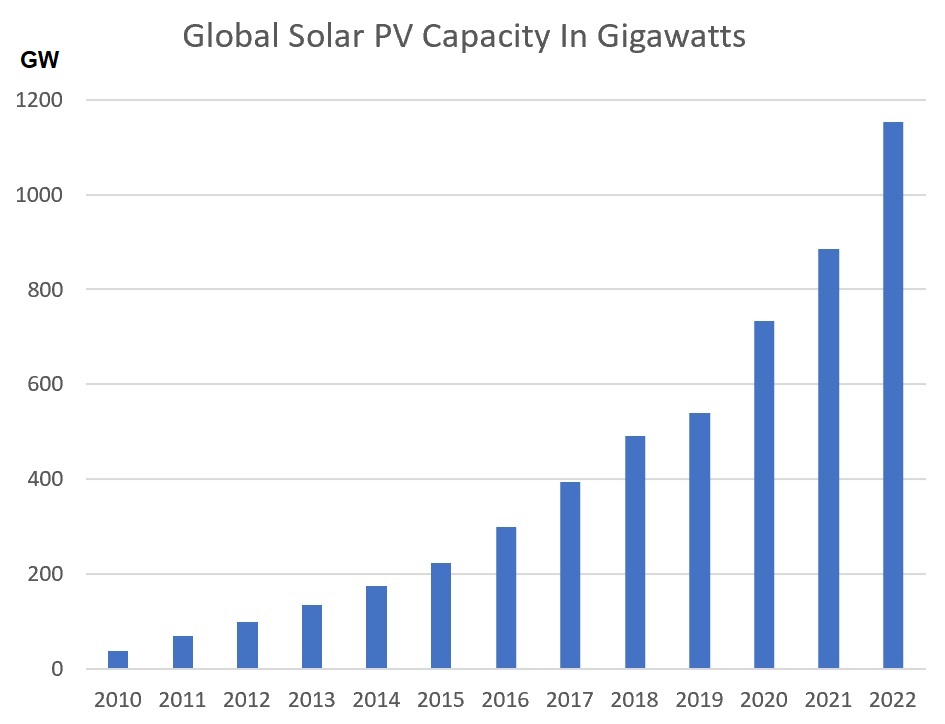
In 2022 solar power provided 4.6% of earth’s electricity. This may not sound like a lot, but it’s twice as much as only three years ago in 2019 and enough to take a hefty bite out of fossil fuel emissions. Bloomberg New Energy Finance estimates 315 GW will be installed next year — enough to raise solar power’s share of energy generation from 4.6% to 5.8%. This rapid growth will continue for years to come.
Wind generation is also expanding rapidly:
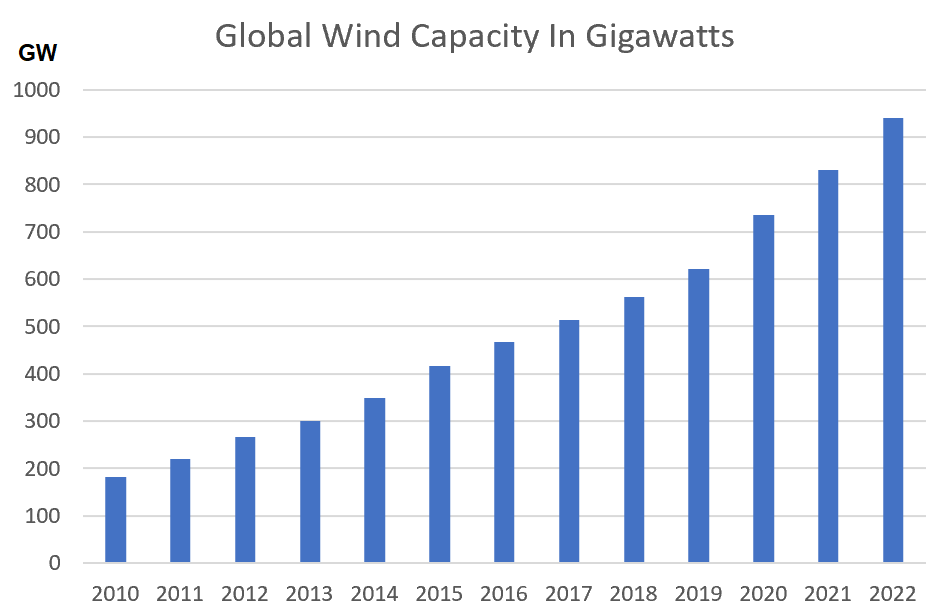
Solar’s capacity exceeded that of wind in early 2021, but wind currently produces more energy thanks to its higher capacity factor. This will soon change because the cost of solar is falling faster, but this won’t stop wind from being an important energy source for the foreseeable future.
Growing electric car sales are helping to keep emissions from oil in check. The graph below shows how many millions of pure electric and hybrid plug-in vehicles are in the world. I used a conservative estimate for 2022, so once the final figures are in it could be higher:
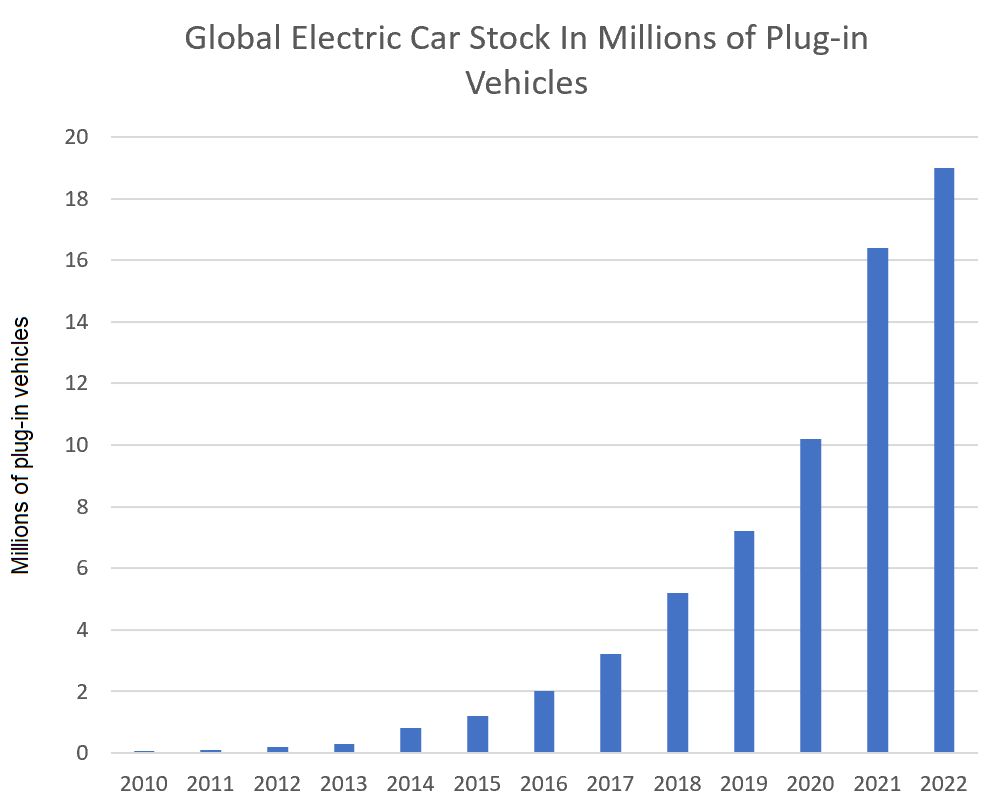
According to this article battery-only EVs are now 11% of new car sales and plug-in hybrids another 4%. There’s still a long way to go before almost every new car has the ability to run off batteries, but if growth continues at this rate it won’t take long.
There’s also large amounts of stationary battery storage under construction around the world. I couldn’t find a good estimate for the amount installed this year, so the figure for 2022 in the graph below is only my educated guess:
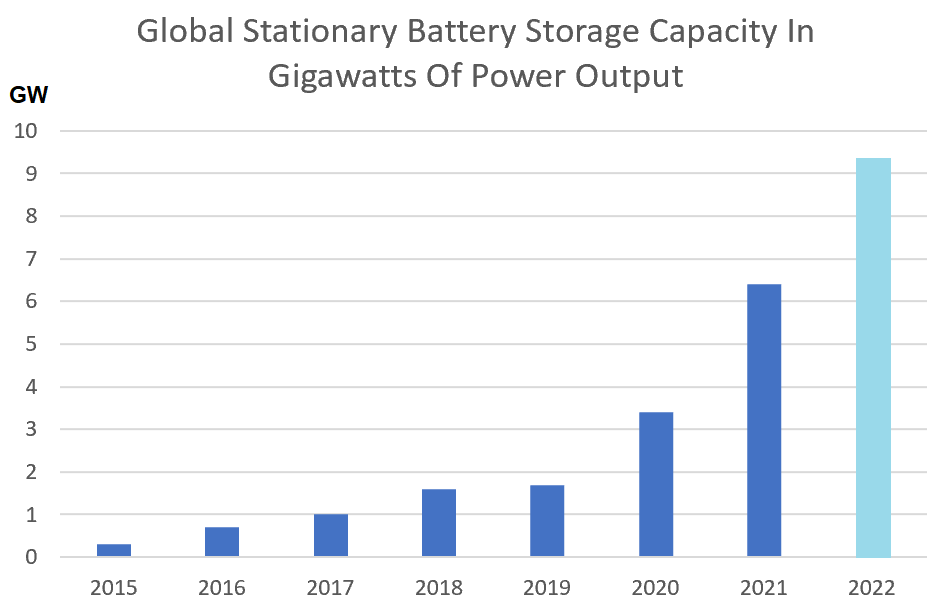
The light blue column for 2022 indicates it’s just my guess. I originally used a column made of question marks, but it made the graph look like it had been designed by a Batman villain.
The figures are in gigawatts (GW) of power output rather than gigawatt-hours (GWh) of energy storage. The number of GWh will be roughly one-third higher than the GW figure.
In addition to stationary battery storage, there will also be a massive amount on wheels inside EVs with the potential to help supply power to homes and the grid. Unfortunately, it may be years before this becomes a practical option for most people.
In addition to batteries, much pumped hydro energy storage is also planned or already under construction. Australia’s Snowy 2 scheme is one example.
Energy Efficiency Is Improving
Australia’s electricity consumption in 2021 was less than 1% higher than in 2011, despite a 15% increase in population thanks mostly to improved efficiency. This trend will continue.
Costs Are Coming Down
Both solar panels and battery storage are likely to see price declines in 2023. There has already been a fall in the cost of solar silicon over the past couple of weeks and further declines are likely. While it’s not expected to decrease by much, lithium is expected to fall in price in 2023 and reduce the price of batteries. A larger fall in lithium prices is expected for 2024 as more mines come online.
These price declines will help keep demand for solar generation and storage high and cut the cost of electric cars. While there may be ups and downs, there will be further price declines over time.
How Could I Be Wrong?
I’m confident 2022 will be humanity’s worst year for greenhouse gas emissions. One reason is the world appears to be heading towards a recession. This will reduce the demand for fossil fuels but it won’t stop the uptake of renewable generation, energy storage, and EVs.
By the time the economy picks up again, I expect emissions will have fallen so far even a huge economic boom won’t push emissions higher than in 2022. But if the world economy in 2023 is strong that may push emissions high enough to create a new record.
If Russia withdraws from Ukraine and attempts to increase natural gas exports, that should boost the world economy. But, since increased gas supply is likely to reduce coal consumption, I don’t think this will cause any large increase in emissions. As no one will want to be dependent on Russian energy it also won’t do much to slow the uptake of renewable generation or efficiency improvements.
Increased Russian oil exports are probably a greater risk, but Russia’s ability to export fossil fuels of any kind has likely deteriorated. Even if their old customers were willing to buy what they used to, I doubt Russia could supply it any time soon.
One thing that could bump emissions higher is a nuclear accident that results in widespread closures of nuclear power stations. While the odds of this happening aren’t high, it is a possibility.
It Should Be Fine!
I am very optimistic 2022 will be the worst year in history for greenhouse gas emissions and no future year will beat it. Thanks to constructive efforts around the world — including by people who’ve taken the very sensible step of putting solar panels on their roofs — soon the question will no longer be, “When will we cut emissions?” It will be, “How fast?”
Original Source: https://www.solarquotes.com.au/blog/2022-greenhouse-gas-emissions/

